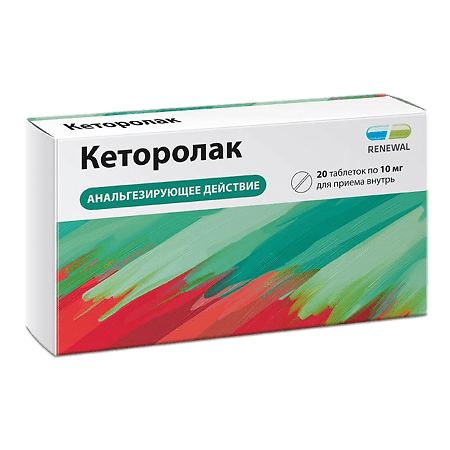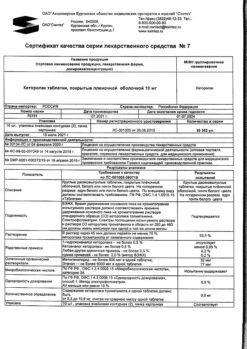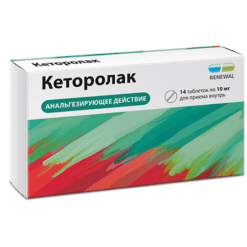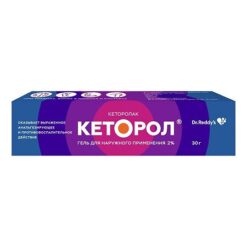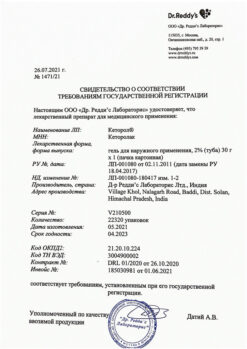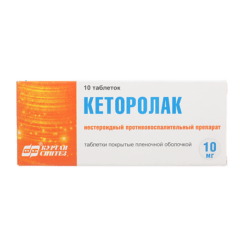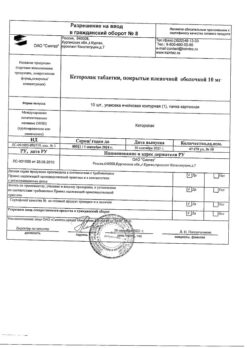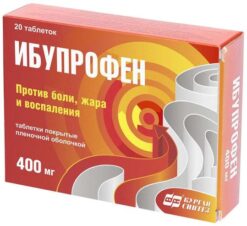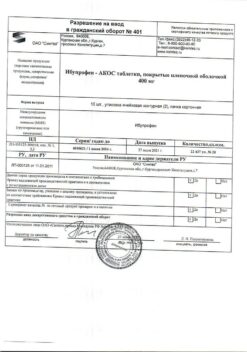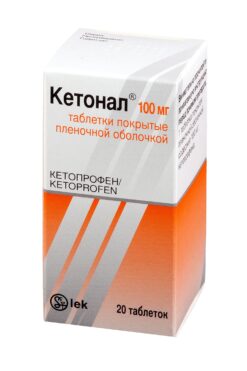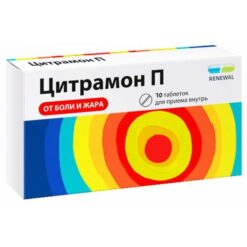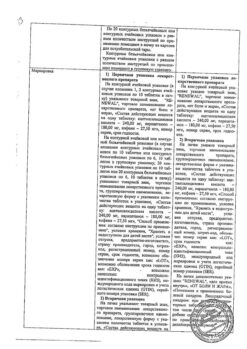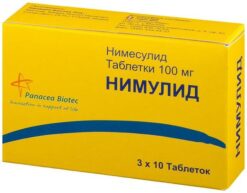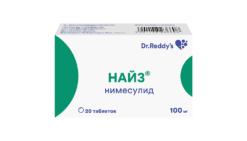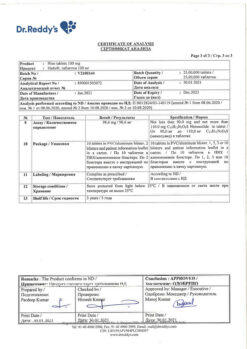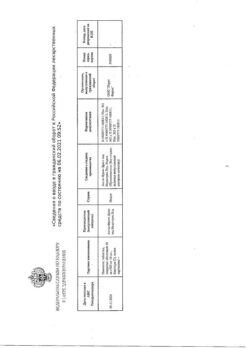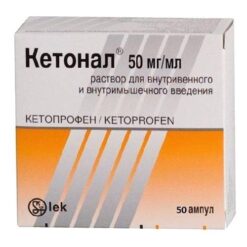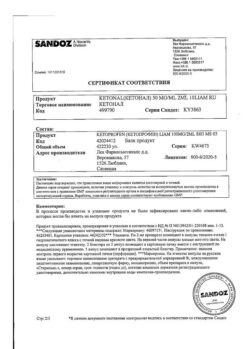No products in the cart.
Ketorolac Reneval, 10 mg 28 pcs.
€2.92 €2.65
Description Pharmacokinetics:
Pharmacotherapeutic group: NSAIDs
ATC code: M01AB15
Ketorolac has pronounced analgesic effect, also has anti-inflammatory and moderate antipyretic effect.
The mechanism of action is related to non-selective inhibition of activity of cyclooxygenase enzyme (COX-1 and COX-2), mainly in peripheral tissues, which results in inhibition of prostaglandin biosynthesis – modulators of pain sensitivity, thermoregulation and inflammation. Ketorolac is a racemic mixture of [-]S and [+]R enantiomers, and the analgesic effect is due to the [-]S form.
Ketorolac does not affect opioid receptors, does not depress breathing, is not addictive and has no sedative or anxiolytic action.
In terms of analgesic effect it is comparable to morphine and is significantly superior to NSAIDs.
After oral administration, the onset of analgesic effect is noted after 1 hour respectively, the maximum effect is achieved after 1-2 hours.
Absorption
When taken orally, ketorolac is well absorbed from the gastrointestinal tract (GIT). Bioavailability is 80-100%. Maximal concentration (Cmaõ) in blood plasma (0.7-1.1 mcg/ml) is reached 40 min after an empty stomach dose of 10 mg of ketorolac. Fat-rich food decreases the Cmax of the drug in plasma and delays its achievement by 1 hour.
Distribution
The binding to plasma proteins is 99%. In hypoalbuminemia the amount of free ketorolac in blood plasma increases.
The time to reach equilibrium concentration (Css) when administered orally is 24 hours when used 4 times a day (above the subtherapeutic dose). Equilibrium concentration in blood plasma after oral administration of 10 mg of ketorolac is 0.39-0.79 mcg/ml. The volume of distribution is 0.15-0.33 l/kg.
Metabolism
More than 50% of the administered dose is metabolized in the liver to form pharmacologically inactive metabolites. The main metabolites are glucuronides, which are excreted by the kidneys, and p-hydroxyketorolac.
Evacuation
Evacuated by the kidneys at 91% (40% as metabolites), 6% – through the intestine.
After oral administration of 10 mg ketorolac, the half-life (T1/2) in patients with normal renal function averages 5.3 hours (2.4-9 hours). Total clearance is 0.025 l/kg/h. It is not excreted during hemodialysis.
Pharmacokinetics in special patient groups
Patients with impaired renal function
In patients with renal impairment, the distribution volume of ketorolac may increase by 2-fold and the distribution volume of its R-enantiomer by 20%.
In patients with renal insufficiency with a plasma creatinine concentration of 19-50 mg/L (168-442 μmol/L), the T1/2 is 10.3-10.8 hours; in more severe renal insufficiency, it is more than 13.6 hours.
The total clearance in renal failure with a plasma creatinine concentration of 19-50 mg/mL when administered orally with 10 mg of ketorolac is 0.016 l/kg/h.
Patients with impaired hepatic function
Hepatic function has no effect on T1/2.
Elderly and younger patients
The T1/2 is longer in older patients and shorter in younger patients.
Lactating mothers
Ketorolac penetrates into breast milk: after mother’s administration of 10 mg of ketorolac the Cmax in milk is reached after 2 hours and is 7.3 ng/ml, respectively; 2 hours after the second dose of ketorolac (when used 4 times daily) – 7.9 ng/ml.
Indications
Indications
Pain syndrome of strong and moderate intensity:
injuries;
toothache;
pain in the postpartum and postoperative period;
oncological diseases;
myalgia;
arthralgia;
neuralgia;
radiculitis;
dislocations, sprains;
rheumatic diseases.
Pharmacological effect
Pharmacological effect
Pharmacotherapeutic group: NSAIDs
ATX code: M01AB15
Ketorolac has a pronounced analgesic effect and also has anti-inflammatory and moderate antipyretic effects.
The mechanism of action is associated with non-selective inhibition of the activity of the enzyme cyclooxygenase (COX-1 and COX-2), mainly in peripheral tissues, resulting in inhibition of the biosynthesis of prostaglandins – modulators of pain sensitivity, thermoregulation and inflammation. Ketorolac is a racemic mixture of [-]S and [+]R-enantiomers, and the analgesic effect is due to the [-]S form.
Ketorolac does not affect opioid receptors, does not depress respiration, does not cause drug dependence, and does not have a sedative or anxiolytic effect.
The strength of the analgesic effect is comparable to morphine, significantly superior to NSAIDs.
After oral administration, the onset of analgesic effect is observed after 1 hour, the maximum effect is achieved after 1-2 hours.
Pharmacokinetics:
Suction
When taken orally, ketorolac is well absorbed from the gastrointestinal tract (GIT). Bioavailability – 80-100%. The maximum concentration (Cmax) in blood plasma (0.7-1.1 mcg/ml) is achieved 40 minutes after taking ketorolac on an empty stomach at a dose of 10 mg. Fat-rich foods reduce the Cmax of the drug in the blood plasma and delay its achievement by 1 hour.
Distribution
Communication with blood plasma proteins – 99%. With hypoalbuminemia, the amount of free ketorolac in the blood plasma increases.
The time to reach equilibrium concentration (Css) when taken orally is 24 hours when used 4 times a day (above the subtherapeutic dose). The equilibrium concentration in blood plasma after oral administration of 10 mg of ketorolac is 0.39-0.79 mcg/ml. The volume of distribution is 0.15-0.33 l/kg.
Metabolism
More than 50% of the administered dose is metabolized in the liver with the formation of pharmacologically inactive metabolites. The main metabolites are glucuronides, which are excreted by the kidneys, and p-hydroxyketorolac.
Removal
91% is excreted by the kidneys (40% in the form of metabolites), 6% through the intestines.
After oral administration of 10 mg of ketorolac, the half-life (T1/2) in patients with normal renal function averages 5.3 hours (2.4-9 hours). Total clearance – 0.025 l/kg/h. It is not excreted during hemodialysis.
Pharmacokinetics in special groups of patients
Patients with impaired renal function
In patients with renal failure, the volume of distribution of ketorolac may increase by 2 times, and the volume of distribution of its R-enantiomer by 20%.
In case of renal failure with a plasma creatinine concentration of 19-50 mg/l (168-442 µmol/l), T1/2 is 10.3-10.8 hours, with more severe renal failure – more than 13.6 hours.
The total clearance in renal failure with a plasma creatinine concentration of 19-50 mg/ml when administered orally with 10 mg of ketorolac is 0.016 l/kg/h.
Patients with liver dysfunction
Liver function has no effect on T1/2.
Elderly and young patients
T1/2 lengthens in elderly patients and shortens in young ones.
Nursing mothers
Ketorolac penetrates into breast milk: after the mother takes 10 mg of ketorolac, Cmax in milk is reached after 2 hours and is 7.3 ng/ml, respectively, 2 hours after taking the second dose of ketorolac (when using the drug 4 times a day) – 7.9 ng/ml.
Special instructions
Special instructions
Before using the drug, it is necessary to find out whether there is a previous allergy to the drug or other NSAIDs. Due to the risk of allergic reactions, the first dose is taken under close medical supervision.
Ketorolac inhibits platelet aggregation and increases blood clotting time. The effect on platelet aggregation ceases 24-48 hours after taking the drug.
Patients with bleeding disorders are prescribed the drug only with constant monitoring of the platelet count, which is especially important in the postoperative period, when careful monitoring of hemostasis is required.
Hypovolemia increases the risk of nephrotoxic adverse reactions.
If necessary, can be used in combination with narcotic analgesics.
Do not use with paracetamol for more than 2 days.
The risk of adverse reactions increases with lengthening the course of treatment and increasing the oral dose of ketorolac to more than 40 mg/day.
Concomitant use of ketorolac with probenecid, pentoxifylline, acetylsalicylic acid and other NSAIDs (including cyclooxygenase-2 inhibitors), lithium salts, anticoagulants (including warfarin and heparin) is contraindicated.
The use of ketorolac for prophylactic pain relief before and during major surgical interventions is contraindicated due to the high risk of bleeding. Ketorolac is not recommended for use as a premedication or maintenance anesthesia.
Cases of fluid retention, increased blood pressure and edema have been reported with the use of ketorolac.
Caution must be exercised when prescribing to patients with heart failure and arterial hypertension.
Concomitant use of ketorolac with other NSAIDs may lead to disorders such as decompensated heart failure and increased blood pressure.
According to clinical studies, the use of certain NSAIDs in high doses may lead to an increased risk of arterial thrombotic complications (eg, myocardial infarction, stroke). Although such complications have not been reported with ketorolac, existing data are insufficient to exclude the risk of such complications.
To reduce the risk of developing NSAID-induced gastropathy, the use of antacid drugs, misoprostol, as well as drugs that reduce gastric secretion (histamine H2 receptor blockers, proton pump inhibitors) is recommended.
To reduce the risk of adverse events, the minimum effective dose of ketorolac should be used for the shortest possible short course.
Impact on the ability to drive vehicles. Wed and fur.:
During the treatment period, side effects from the central nervous system (drowsiness, dizziness, headache) may develop, which reduces the speed of mental and motor reactions and therefore it is necessary to refrain from driving vehicles and engaging in other potentially hazardous activities that require increased concentration and speed of psychomotor reactions.
Active ingredient
Active ingredient
Ketorolac
Composition
Composition
Active ingredients:
Ketorolac (Ketorolac tromethamine) – 10.00 mg
Excipients:
microcrystalline cellulose – 122.41 mg
corn starch – 44.76 mg
colloidal silicon dioxide (aerosil) – 1.83 mg
magnesium stearate − 1.00 mg
Shell composition:
hypromellose – 2.91 mg
titanium dioxide – 1.25 mg
Macrogol 400 (polyethylene glycol 400) – 0.68 mg
talc – 0.16 mg.
Contraindications
Contraindications
Hypersensitivity (including to other non-steroidal anti-inflammatory drugs);
complete or incomplete combination of bronchial asthma, recurrent polyposis of the nose and paranasal sinuses and intolerance to acetylsalicylic acid or other non-steroidal anti-inflammatory drugs (including a history);
erosive and ulcerative lesions of the gastrointestinal tract (GIT), active gastrointestinal bleeding;
inflammatory bowel diseases (including ulcerative colitis, Crohn’s disease);
diseases of the bone marrow and blood (leukopenia, including a history of thrombocytopenia, hypocoagulation (including hemophilia)), myelosuppression, bleeding or a high risk of their development;
severe renal failure (creatinine clearance (CC) less than 30 ml/min), confirmed hyperkalemia;
severe liver failure or active liver disease;
condition after coronary artery bypass surgery;
preventive pain relief before and during major surgical interventions due to the high risk of bleeding;
active cerebrovascular diseases (including intracranial hemorrhage or suspicion of it); pregnancy;
period of childbirth;
breastfeeding period; children under 16 years of age (safety and effectiveness of use have not been established);
simultaneous use with probenecid;
simultaneous use with pentoxifylline; simultaneous use with acetylsalicylic acid and other non-steroidal anti-inflammatory drugs (including cyclooxygenase-2 inhibitors);
simultaneous use with lithium salts;
simultaneous use with anticoagulants (including warfarin and heparin).
With caution:
Bronchial asthma; the presence of factors that increase gastrointestinal toxicity: alcoholism, smoking and cholecystitis; postoperative period; chronic heart failure; edema syndrome; arterial hypertension; moderate renal failure (creatinine clearance 30-60 ml/min); cholestasis; active hepatitis; sepsis; systemic lupus erythematosus; coronary heart disease; cerebrovascular diseases; dyslipidemia/hyperlipidemia; diabetes mellitus; peripheral arterial disease; a history of ulcerative lesions of the gastrointestinal tract, the presence of Helicobacter pylori infection; long-term use of NSAIDs; severe somatic diseases; thyroid diseases; tuberculosis; simultaneous use of oral glucocorticosteroids (including prednisolone), antiplatelet agents (including clopidogrel), selective serotonin reuptake inhibitors (including citalopram, fluoxetine, paroxetine, sertraline); old age (over 65 years).
Side Effects
Side Effects
The incidence of adverse events (AEs) is classified according to the recommendations of the World Health Organization, characterized as: very often – at least 10%; often – at least 1%, but less than 10%; infrequently – not less than 0.1%, but less than 1%; rarely – not less than 0.01%, but less than 0.1%; very rare, including isolated cases – less than 0.01%; frequency unknown (frequency cannot be determined from available data).
From the digestive system
Often (especially in elderly patients over 65 years of age with a history of erosive and ulcerative lesions of the gastrointestinal tract) – gastralgia, diarrhea;
infrequently – stomatitis, flatulence, constipation, vomiting, feeling of fullness of the stomach;
rarely – nausea, erosive and ulcerative lesions of the gastrointestinal tract (including with perforation and/or bleeding – abdominal pain, spasm or burning in the epigastric region, melena, vomiting like “coffee grounds”, nausea, heartburn), cholestatic jaundice, hepatitis, hepatomegaly, acute pancreatitis.
From the urinary system
Rarely – acute renal failure, lower back pain, hematuria, azotemia, hemolytic-uremic syndrome (hemolytic anemia, renal failure, thrombocytopenia, purpura), frequent urination, oliguria, polyuria, interstitial nephritis, edema of renal origin;
frequency unknown – urinary retention.
From the senses
Rarely – hearing loss, ringing in the ears, visual impairment (including blurred vision);
frequency unknown – taste disturbance.
From the respiratory system
Rarely – bronchospasm or dyspnea, rhinitis, laryngeal edema (shortness of breath, difficulty breathing).
From the central nervous system
Often – headache, dizziness, drowsiness;
rarely – aseptic meningitis (fever, severe headache, convulsions, stiffness of the neck and/or back muscles), hyperactivity (mood changes, anxiety), hallucinations, depression, psychosis.
From the cardiovascular system
Uncommon: increased blood pressure;
rarely – pulmonary edema, fainting.
From the hematopoietic organs
Rarely – anemia, eosinophilia, leukopenia.
From the hemostasis system
Rarely – bleeding from a postoperative wound, nosebleeds, rectal bleeding.
From the skin
Uncommon: skin rash (including maculopapular rash), purpura;
rarely – exfoliative dermatitis (fever with or without chills, redness, thickening or flaking of the skin, swelling and/or tenderness of the tonsils), urticaria, Stevens-Johnson syndrome, Lyell’s syndrome.
Allergic reactions
Rarely – anaphylaxis or anaphylactoid reactions (change in facial skin color, skin rash, urticaria, itching, tachypnea or dyspnea, swelling of the eyelids, swelling of the tongue, periorbital edema, shortness of breath, difficulty breathing, heaviness in the chest, wheezing).
Others
Often – swelling (face, legs, ankles, fingers, feet, weight gain);
infrequently – increased sweating;
rarely – fever;
frequency unknown – hyperkalemia, hyponatremia.
Interaction
Interaction
The simultaneous use of ketorolac with acetylsalicylic acid or other NSAIDs, calcium preparations, glucocorticosteroids, ethanol, corticotropin can lead to a significant increase in the risk of adverse reactions, including the formation of gastrointestinal ulcers and the development of gastrointestinal bleeding.
The simultaneous use of ketorolac with anticoagulants (including warfarin, heparin), other NSAIDs, pentoxifylline and probenecid is contraindicated.
When ketorolac is used simultaneously with other NSAIDs (including cyclooxygenase-2 inhibitors), fluid retention, cardiac decompensation, and increased blood pressure may occur.
The simultaneous use of ketorolac with indirect anticoagulants, thrombolytics, antiplatelet agents, cefoperazone, cefotetan and pentoxifylline increases the risk of bleeding.
Probenecid reduces the plasma clearance and volume of distribution of ketorolac, increases its concentration in the blood plasma and increases its half-life.
The combined use of ketorolac with sodium valproate causes a disorder of platelet aggregation.
When using ketorolac with other nephrotoxic drugs (including gold preparations), the risk of developing nephrotoxicity increases. Combined use with paracetamol increases the nephrotoxicity of ketorolac. Drugs that block tubular secretion reduce the clearance of ketorolac and increase its concentration in the blood plasma.
The combined use of ketorolac with methotrexate increases the hepato- and nephrotoxicity of methotrexate. The combined use of ketorolac and methotrexate is possible only when using low doses of the latter. The clearance of methotrexate may decrease (it is necessary to monitor the concentration of methotrexate in the blood plasma).
With the use of ketorolac, it is possible to reduce the clearance of lithium, increase its concentration in the blood plasma, and increase the toxic effect of lithium. Simultaneous use with lithium salts is contraindicated.
Ketorolac reduces the effect of antihypertensive and diuretic drugs (the synthesis of prostaglandins in the kidneys is reduced).
Ketorolac enhances the effect of narcotic analgesics. When combined with opioid analgesics, the doses of the latter can be significantly reduced.
Ketorolac enhances the hypoglycemic effect of insulin and oral hypoglycemic drugs, and therefore it is necessary to recalculate the dose of these drugs.
Ketorolac increases the plasma concentrations of verapamil and nifedipine.
Concomitant use of NSAIDs and mifepristone may reduce the effectiveness of mifepristone. NSAIDs are not recommended for use within 8-12 days after using mifepristone.
Concomitant use of NSAIDs and cyclosporine increases the risk of nephrotoxicity.
The simultaneous use of NSAIDs and quinolone antibiotics increases the risk of developing seizures.
Concomitant use of NSAIDs and tacrolimus increases the risk of nephrotoxicity.
Concomitant use of NSAIDs and zidovudine increases the risk of hematological toxicity.
When used simultaneously with digoxin, ketorolac does not interfere with the binding of digoxin to plasma proteins. Therapeutic concentrations of digoxin do not affect the binding of ketorolac to plasma proteins.
Antacids do not affect the absorption of ketorolac.
Myelotoxic drugs increase the manifestations of hematotoxicity of ketorolac.
Overdose
Overdose
Symptoms: abdominal pain, nausea, vomiting, peptic ulcers or erosive gastritis, impaired renal function, metabolic acidosis.
Treatment: gastric lavage, administration of adsorbents (activated carbon) and symptomatic therapy (maintaining vital functions in the body). Ketorolac is not sufficiently eliminated by hemodialysis.
Storage conditions
Storage conditions
In a place protected from light, at a temperature not exceeding 25 ° C.
Keep out of the reach of children.
Shelf life
Shelf life
3 years.
Do not use after expiration date.
Manufacturer
Manufacturer
Update of PFC JSC, Russia
Additional information
| Shelf life | 3 years. Do not use after the expiration date. |
|---|---|
| Conditions of storage | In the dark place at a temperature not exceeding 25 °С. Store out of the reach of children. |
| Manufacturer | Update PFC AO, Russia |
| Medication form | pills |
| Brand | Update PFC AO |
Other forms…
Related products
Buy Ketorolac Reneval, 10 mg 28 pcs. with delivery to USA, UK, Europe and over 120 other countries.

